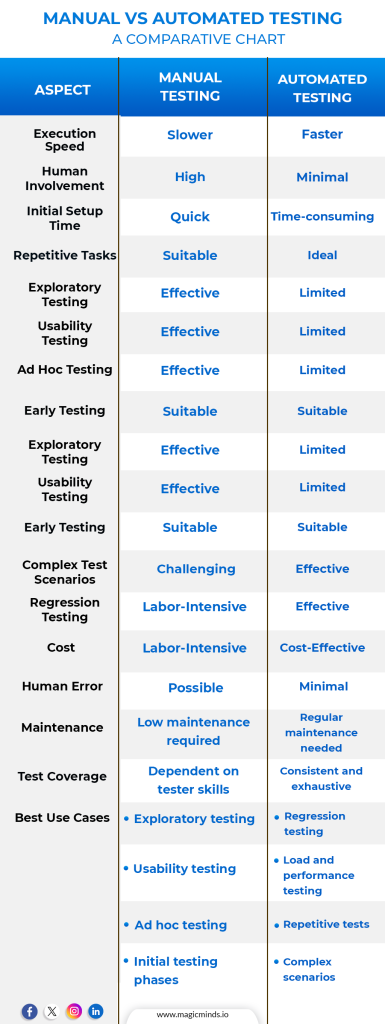Manual vs Automated Testing: What’s Best for You?

Tags
Category
- All
- Android App Development
- API
- App Store
- Artificial Intelligence
- Blockchain Development
- Chatbot Development
- CMS Development
- Cybersecurity
- Data Security
- Digital Marketing
- Ecommerce Development
- Fintech
- Flutter app development
- Full Stack Development
- iOS App Development
- IT Project Management
- JavaScript development
- Laravel Development
- Magento Development
- Mobile App
- Mobile App Development
- Progressive Web Application
- python development
- QA and testing
- React Native
- SaaS
- SEO
- Shopify Development
- Software Development
- Staff Augmentation
- UI/UX Development
- Web analytics tools
- Wordpress Development
In the realm of the software development world, testing is a must to enjoy greater integrity, avoiding that may cause serious issues related to the software application project and, sometimes, user dissatisfaction. Software testing ensures the better delivery of the application with more flexibility.
The importance of software testing is enormous, which we will discuss another day. But today, we will mainly focus on the software testing options— having manual testing and automated testing on the plate.
You must be wondering how to choose between manual and automatic testing. Our blog discusses the strengths of manual and automated testing and which one you should opt for. So, without further ado, let’s have a look at it.
Manual vs Automated Testing: A Quick Brief
- Why Should You Use Automated Testing?
- Why Should You Use Manual Testing?
- Is Automated Testing Capable To Replace Manual Testing?
- Manual vs Automated Testing: A Comparative Chart
- When to Use Manual Testing
- When to Use Automated Testing
Manual vs Automated Testing: A Quick Brief
Manual testing involves a process where testers manually go through different app features or websites to detect bugs, errors, etc., for better software application functionality.
On the other hand, automated testing is a process where frameworks, robust tools, and strong testing scripts automate the requirements for testing the website or app features.
Manual vs Automated Testing: Why Should You Use Automated Testing?
As previously mentioned, automated testing uses tools and scripts to automate software testing. While doing software testing, why do you prefer automated testing? Let’s check the prime benefits of using automated testing.
Time Management
One of the top reasons for automated testing preference is its time management feature. This testing allows professionals to run multiple tests in less time. Even automated testing has been initiated because manual testing is time-consuming.
Besides, the faster-automated testing meets the deadline and quickens the go-to-market needs, increasing productivity and streamlining the workflow of the software functionalities.
Eliminates Repetitive Tasks
The biggest pro of implementing automated testing is it streamlines the testing process, eliminating repetitive tasks during the testing phase. This enables more productivity and flexibility in the software application, providing an enriched user experience.
Moreover, writing testing scripts is difficult, right? Java, JavaScript, Python, and C# codes are used to write test scripts for your information, which are challenging. However, automated testing equips QA testers with robust tools to develop code and write test scripts. Besides, you can re-use the test scripts, adding value and efficiency further down the lane.
Cost-Effective
Statista reports that 23% of companies allocate their annual IT budgets to QA and testing. Adopting automated software testing proves a cost-saver for any dedicated software development service. This testing generates the automation process for testing purposes, eventually requiring less energy and resources.
This makes the entire automated testing more cost-effective and efficient than manual testing.
Seamless Performance Testing
The performance of automated testing is better and faster. The high-speed performance of automated testing is a boon in the software testing world. This adds more flexibility, agility, and scalability to the software applications.
Moreover, the performance testing by automated process is quick and effortless. The automated testing procedure enables Spike Testing, Stress Testing, Load Testing, and more effectively through the automation tools Testsigma, Selenium, Appium, Watir, etc.
RELATED READ: Guide 101: Third-Party API Integration in Android Apps
Automation Tool Features
The automation tools possess robust and cutting-edge real-user simulation technology that helps to do some new-age and advanced tests, such as face ID, fingerprint test, location mocking, image testing, voice recognition testing, network visualization testing, and the list goes on.
Manual Vs. Automated Testing: Why Should You Use Manual Testing?
Although automated testing is a buzzword nowadays in many cases, many QA testers religiously follow manual testing over automated testing. But why should you choose manual testing? Let’s quickly check the power of manual testing.
Flexibility
Manual testing enables quality assurance (QA) testers to run the test and fetch the result immediately. As automated testing requires time and effort in setting up the process, manual testing is a good choice for getting accurate results, adding flexibility in the pipeline.
Short-term project
Manual testing software is better when it comes to short-term project completion as short-term projects involve minor features and less coding, which is cost-effective when manual testing is done.
Otherwise, automatic testing would have taken planning and investment and has a narrow scope for which cost would be too high to match.
End-user Usability
No matter how advanced we become, we can not replace manpower. No machine can decide whether any application is good enough for a human. Yes, it can try to understand if it’s good enough from the end user’s perspective, but it can not judge its satisfaction without the actual manpower testing it.
Therefore, no matter how much-wandering automation testing looks and feels like, manual testing is the ultimatum when understanding the sensibilities and improvising and implementing that in software development testing.
Moreover, manual testing is better for UX testing, and in complex test scenarios, manual testing is the best choice ever for test efficiency.
RELATED READ: UX Mastery: A Blueprint for Mobile App Development Success
Is Automated Testing Capable To Replace Manual Testing?
Well, the answer is a big no! Automated testing has a lot of benefits and provides better, faster software performance with excellent customer experience, reducing the time and effort of the testers. On the other hand, manual testing is a time-taking process; however, it is preferable for better UX testing, critical and challenging test situations, and handling short-term projects.
Let’s take an example– the distance between your home and office is about 1 hour of walking. But while going to work, if you take a car or cab, it takes 15 minutes for you to get there. But still, it requires human effort. In the same way, automated testing can make the process faster and more reliable, but you need a human drive to make the process happen.
We understand you are trying to determine whether you should depend on automated or manual testing. Before that, you must understand both of these tests have strengths and weaknesses, and lastly, it totally depends on you which one you need.
You must understand the project requirements and time needed for that and decide whether to go for manual or automated testing. So, your project requirements have the last say in your preference for testing options.
Manual vs Automated Testing: A Comparative Chart

When to Use Manual Testing
- For initial exploratory testing, usability testing, and ad hoc testing.
- During early stages of development when test cases are evolving rapidly.
- When human judgment, intuition, and creativity are required.
- For testing user interfaces and ensuring a positive user experience.
When to Use Automated Testing
- For repetitive and regression testing, especially when multiple test cycles are needed.
- When testing complex scenarios and conducting load and performance testing.
- To achieve consistent and exhaustive test coverage.
- When cost-efficiency and faster execution are essential.
- In agile or continuous integration/continuous deployment (CI/CD) environments.
It’s important to note that a combination of both manual and automated testing is often the most effective approach in real-world scenarios, as each has its own strengths and limitations. Manual testing allows for the human element and critical thinking, while automated testing offers efficiency and consistency. The choice depends on the specific needs and context of your testing project.
Conclusion
To conclude, software testing is essential for better performance, so that you can prefer manual or automated testing. Manual testing is beneficial for handling complex test cases, whereas automated testing is helpful for simpler tests and avoiding repetitive tasks. However, ultimately, it is your responsibility to select any of the testing processes for longer results. For the best bug-free software development outcome, you can hire dedicated software developers or consult a proficient software development company like Magicminds. We are here to help you with software development and testing processes more efficiently than ever!
Read more on our Blog
Explore cutting-edge technologies with us. Dive into the latest tech stories, news, tips, and stay updated. Join our digital journey.










